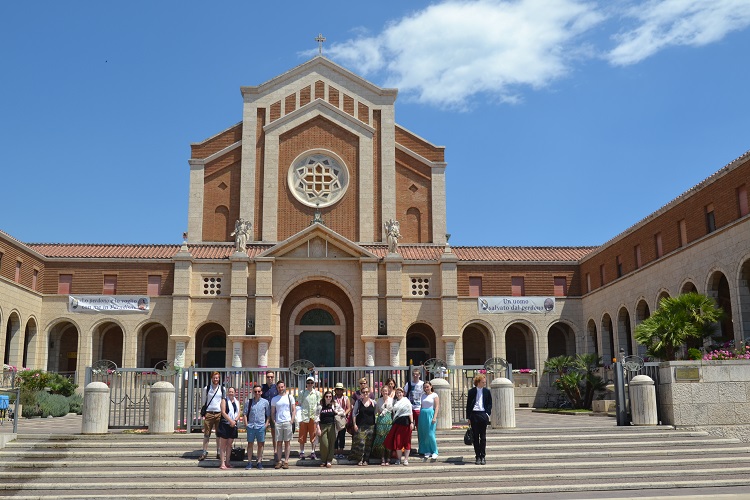
Mass at the English College
We had another lovely day in Rome, where we set off for the English College for morning Mass. Inside the college, one is struck by the beauty of the chapel, with its tasteful decoration and inspiring artwork.
The Mass itself was beautifully led, by both the clergy and the musicians. It must be said that the quality of the music can often determine how one experiences the Mass, and at the English College they did a great job in amplifying the reverential and transcendent nature of the Mass.
Afterwards, we were given a tour around some of the rooms of the college, by former Diocese of Westminster employee and now seminarian Alex. He talked about the history of the place, the frescos and so on.
We then went for lunch in our own little groups. We had a couple of hours before having to meet up for our trip to Nettuno, the home of Saint Maria Goretti.
The journey to Nettuno took about an hour by coach. It was interesting to see more of the country as my four previous experiences of Italy had all been confined to Rome.
Sunny Nettuno
Nettuno itself struck me as a pleasant seaside town. There were lots of boats in the harbour, authentic, sandy beaches, little gift shops dotted around coastline and the general sense of a buzzing little coastal town. But what made this perhaps classic coastal scene unique was the sanctuary basilica dedicated to Saint Maria Goretti.
Facing along the coast, I was struck by the basilica’s colours and shape. The warm colours worked well, given its location, and the front façade, along with the arms protruding forward from both sides gave it an almost St Peter’s Basilica feel – albeit on a much smaller scale.
Indeed, it was quite pleasant to just sit in the walkway of one of the arms, enjoying the breeze, the blue skies and reflecting on why we were here.
Now the basilica wasn’t open when we had arrived; we had to wait half an hour. So a number of people went to the beach – 30 seconds away – to enjoy the sun and sea. I opted to buy some chips from the nearby beach hut and coordinated the payment of renting beach parasols and beds between one of the local girls and our group. But as 3pm came, I made my way to the basilica.
One detail I’ve yet to mention about the front of the basilica – perhaps because it is a temporary feature – is the colourful flower petal arrangements that came down the steps from the basilica and continued to the gated entrance. The floral decoration was beautiful, particularly with the gloriously sunny weather.
Inside the Basilica of Maria Goretti
Entering the basilica, I was perhaps somewhat surprised by the interior’s relative simplicity. I say relative because compared to the ornate, detailed churches in Rome, the Basilica of Maria Goretti is quite plain, with not even a single decoration on the giant, white wall at the back of the building.
Indeed, it seemed to me that much of the design had been inspired by that post-war architectural style that, for me, is perhaps not the most attractive or inspiring.
Nevertheless, it was great to be here, and I spent plenty of time looking around, entering the side rooms and reading about the life and history of Saint Maria Goretti.
Maria’s story
For those unaware, Maria died when she was just 11 years old. She came from simple, humble beginnings and her family shared a house with another family. That other family had a son who on more than one occasion had tried to have intimate relations with the young girl.
Then, one day, is sinful lust overwhelmed his senses and, after Maria had resisted him once again, he drew a knife and stabbed her multiple times.
Before dying from her wounds, Maria forgave her attacker. It was this great act of forgiveness that makes her the patron saint of forgiveness, as well as other things such as rape victims and young people.
The impact of Maria Goretti
I think there’s much that can be learned from the short, but impactful, life of Maria. For me, she shows that we can – and must – stand up against tyranny, even in the face of suffering. She also shows that forgiveness is always possible, and necessary.
Maria displayed an incredible ability to forgive, similar to another saint, John Paul II. After he was shot in St Peter’s Square, he met his would-be assassin in prison and forgave him.
In the crypt of the basilica lies Maria Goretti’s body. In the silence of the room, alone with the saint, there was an almost ethereal moment. As I prayed there, I considered the powerful witness of this young Catholic.
How important it is, that we stand firm in the faith, that we don’t give in to sin, and that we be an example of Christ to everyone we meet, including those who misunderstand and hate us.
Shortly after, it was time to re-board the coach and head back to Rome. I reflected on this experience in Nettuno, visiting the shrine of this young saint.
More young people need to know about Maria Goretti – she’s an example for all of us!
Subscribe to our Newsletter
Sign up to receive our fortnightly email with our latest news, features and events…
See our Privacy Policy here.